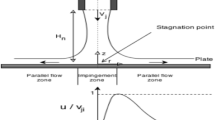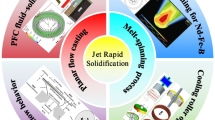Abstract
In what follows, a model is developed that describes the optimal processing parameters for directional solidification using liquid metal cooling (LMC). The model considers a sample with a flat geometry and, as a first approximation, can be used to treat the flat sections of a turbine blade. The model predicts (1) the optimal withdrawal rate of the casting from the hot zone, (2) the temperature gradient in the liquid at the solidification interface, and (3) the temperature profile along the length of the casting. The model is then used to perform a sensitivity analysis of the LMC process. Cooling bath temperature, baffle thickness, shell thickness, and shell thermal conductivity are shown to have a strong influence on system performance.
Similar content being viewed by others
References
T.J. Fitzgerald and R.F. Singer: Proc. 2nd Pacific Rim Int. Conf. on Modeling of Casting and Solidification Processes, E. Niyama and H. Kodama, eds., Hitachi Ltd., Hitachi, 1995, pp. 201–16.
A.F. Giamei and J.G. Tschinkel: Metall. Trans. A, 1976, vol. 7A, pp. 1427–34.
A.F. Giamei, E.H. Kraft, and F.D. Lemkey: New Trends in Materials Processing, ASM, Metals Park, OH, 1976, pp. 48–97.
J.S. Erickson, C.P. Sullivan, and F.L. Versnyder: in High Temperature Materials in Gas Turbines, P.R. Sahm and M.O. Speidel, eds., Elsevier Scientific Publishing Company, Amsterdam, 1974, pp. 315–43.
Robert F. Singer: in Materials for Advanced Power Engineering, Part II, D. Coutsouradis et al., eds., Kluwer Academic Publishers, Dortrecht, 1994, pp. 1707–1729.
P.J. Prescott, F.P. Incropera, and W.D. Bennon: Int. J. Heat Mass Transfer, 1994, vol. 34, pp. 2351–59.
D.G. Neilson and F.P. Incropera: Int. J. Heat Mass Transfer, 1991, vol. 34, pp. 1717–32.
G.C. Bart, C.J. Hoogendoorn, and P.B. Schaareman: J. Solar Energy Eng., 1986, vol. 108, pp. 310–15.
A.V. Kuznetsov and K. Vafai: Int. J. Heat Mass Transfer, 1995, vol. 38 (14), pp. 2557–67.
M.C. Flemings: Solidification Processing, 1st ed., McGraw-Hill, New York, NY, 1974, pp. 146–54 and pp. 342–43.
S.S. Kutatelandze, S. Samson, and V.M. Borishanskii: Liquid Metal Heat Transfer Media, 1st ed., Chapman & Hall Ltd., London, 1959, pp. 82–86.
J.K. Tien and R.P. Gamble: Proc. 2nd Int. Conf. on the Strength of Metals and Alloys, ASM, Pacific Grove, CA, 1970, pp. 1037–41.
M. McLean: Directionally Solidified Materials for High Temperature Applications, 1st ed., The Metals Society, London, 1983, pp. 169–75.
Author information
Authors and Affiliations
Rights and permissions
About this article
Cite this article
Fitzgerald, T.J., Singer, R.F. An analytical model for optimal directional solidification using liquid metal cooling. Metall Mater Trans A 28, 1377–1383 (1997). https://doi.org/10.1007/s11661-997-0274-4
Received:
Issue Date:
DOI: https://doi.org/10.1007/s11661-997-0274-4




